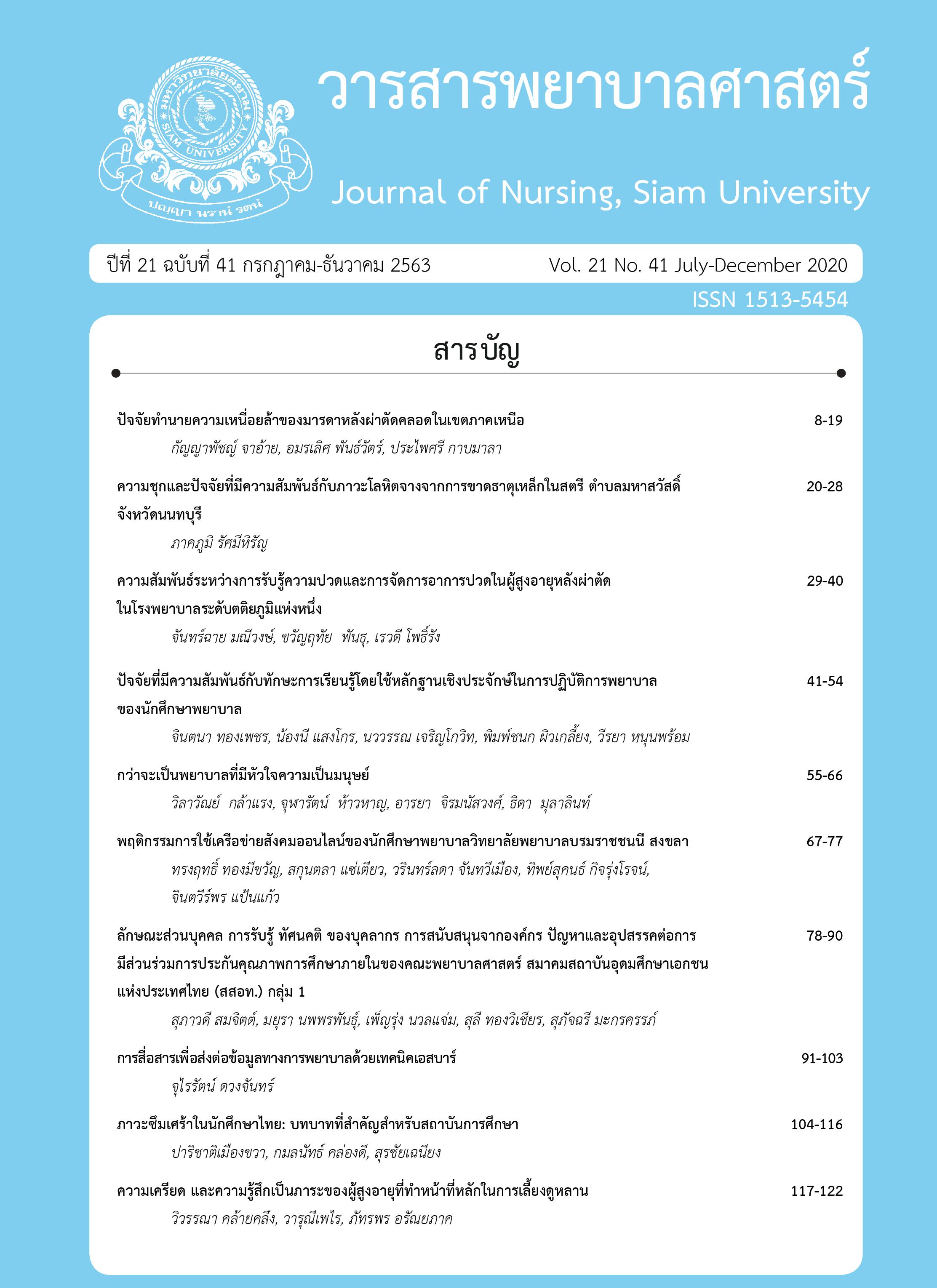Predicting Factors of fatigue in Postpartum mothers undergoing Cesarean section in Northern Thailand
DOI:
https://doi.org/10.14456/jnsu.v21i41.244563Keywords:
Fatigue, Postpartum mother, Cesarean Section, Northern ThailandAbstract
The research was aimed at examining level and predictive factors for fatigue in postpartum mothers who have undergone cesarean section in northern Thailand. The data were collected from 259 postpartum mothers 48, and 72 hours after cesarean section at postpartum wards or gynecological wards of 9 hospitals in northern Thailand. The data were collected using a questionnaire. The questionnaire consisted of 6 parts, namely 1) demographic data, 2) medical records, 3) the postoperative pain wound, 4) postoperative fatigue, 5) sleep disturbances and 6) the maternal role stress. Data collection took place during the period of July 2018 to October 2019. Descriptive statistics and multiple regression were used to analyze the data.
The results revealed that mothers had a moderate level of fatigue after 48 hours and also 72 hours after birth. The postoperative pain wound, sleep disturbance and maternal role stress were found to be the predictors and could explain 28.10% and 12.10% of the variances in fatigue at 48 hours and 72 hours after birth.
Conclusion: Mothers should be planned to arrange the postoperative wound pain, promoting maternal sleep and adjust appropriately stress management in a postpartum maternal role. There can help the mother to reduce fatigue after the cesarean section.
References
cause, Prevention and Treatment. ในประยุทธ์ ศิริวงษ์ สมบุญ เจริญเศรษฐมห และ ปริญญา ทวีชัยการ (บรรณาธิการ). ศัลยศาสตร์ วิวัฒน์ 32: current practice in colorectal surgery. กรุงเทพฯ: กรุงเทพเวชสาร. หน้า83- 110.
จรัสศรี ธีระกุลชัย ชุติมา โฆวัฒนะกุล ศิวพร สังวาล และสุวรรณี วังกานต์. (2543). ความเหนื่อยล้า ของมารดาในระยะหลังคลอด. วารสารวิจัย ทางการพยาบาล, 4(1), 78-90.
จันทรรัตน์ เจริญสันติ. (2554). การส่งเสริมการเลี้ยงนมมารดา. ในอภิรัช อินทรางกูร ณ อยุธยา (บรรณาธิการ). ความรู้เบื้องต้นการพยาบาล ผดุงครรภ์. เชียงใหม่: คณะพยาบาลศาสตร์ มหาวิทยาลัยเชียงใหม่. หน้า 291.
ดวงกมล ปิ่นเฉลียว. (2552). การพยาบาลมารดาที่ได้รับ การผ่าตัดคลอดทางหน้าท้อง การคลอดโดยใช้ คีมและเครื่องสูญญากาศ (พิมพ์ครั้งที่ 3). กรุงเทพฯ: โครงการสวัสดิการวิชาการ สถาบัน พระบรมราชชนก.
ดวงกมล ปิ่นเฉลียว และพรพรรณ ภูสาหัส. (2558). ปัจจัยที่มีความสัมพันธ์กับความทุกข์ทรมานของ สตรีหลังผ่าตัดคลอด. วารสารพยาบาลทหารบก , 16(1), 101-108.
นันทวรรณ พลสุวรรณ ผ่องศรี ศรีมรกต จงจิต เสน่หา และพรชัย โอเจริญรัตน์. (2557). ปัจจัย ทำนาย คุณภาพการนอนหลับของสตรีที่เป็น มะเร็ง เต้านมหลังจากได้รับยาเคมีบำบัด. วารสาร พยาบาลสงขลานครินทร์. 34(3), 19-38.
รัชดา วงษ์นิพนธ์. (2552). ความเหนื่อยล้าในมารดาหลัง คลอดที่ได้รับการผ่าตัดคลอด. (วิทยานิพนธ์ พยาบาลศาสตร์มหาบัณฑิต สาขาการพยาบาล มารดาและทารกแรกเกิด). บัณฑิตวิทยาลัย มหาวิทยาลัยมหิดล, คณะพยาบาลศาสตร์.
รัตนา แทนไธสง และสมพร วัฒนนุกูลเกียรติ. (2560). ความสัมพันธ์ระหว่างการปรับตัวต่อบทบาท มารดา การรบกวนการนอนหลับ การสนับสนุน ทางสังคม และความเหนื่อยล้ากับความเครียด ในมารดาหลังคลอดอายุมาก. วารสารพยาบาล ศาสตร์และสุขภาพ. 40(3), 12-23.
ศิลปชัย ฝั้นพะยอม กรรณิการ์ กันธะรักษา และฉวี เบาทรวง. (2557). การทบทวนวรรณกรรมอย่าง เป็นระบบเกี่ยวกับการจัดการอาการเหนื่อยล้า ในสตรีหลังคลอด. วารสารพยาบาลสาร, 41(3), 60-69.
สถิติการคลอด. (2561). การผ่าตัดคลอด. เข้าถึงข้อมูลเมื่อ วันที่ 15 พฤษภาคม 2561 จาก, http://healthregion1.chiangmaihealth.go. th/frontend/web/cmi/report/service?co_ thip_new=CM0105.
สุธีรา เอื้อไพโรจน์กิจ. (2563). การขับถ่ายของทารก. เข้าถึงข้อมูลเมื่อวันที่ 10 กุมภาพันธ์ 2563 จาก, https://www.doctorbreastfeeding.com
หน่วยเวชศาสตร์มารดาและทารก คณะแพทยศาสตร์ มหาวิทยาลัยเชียงใหม่ (2562). สถิติการผ่าตัด คลอด สถิติรายงานประจำปีของหน่วยเวช ศาสตร์มารดาและทารก เข้าถึงข้อมูลเมื่อวันที่ 28 มิถุนายน 2563 จาก, https://w1.med.cmu.ac.th/obgyn/images /stories/MFM/Statistics/MFM19.pdf
Antoni, C., Antonio, O., Julio, C., Jolanda, V., & Miguel, R. (2017). The fatigue assessment scale: reliability and validity assessment in postpartum woman. Retrieved 10 December 2018. From, www.ncbi.nlm.gov/pmc/article/pmc5622 603
Bakker, M., Van der Beek, A. J., Hendriksen, J. M., Bruinvels, D. J., & Van Poppel, M. N. M. (2014). Predictive factors of postpartum fatigue: A prospective cohort study among working woman. Journal of psychosomatic research, 77, 385-390.
Cooklin, AR., Giallo, R, & Rose, N. (2012). Parental fatigue and parenting practices during early childhood: an Australian community survey. Child: Care, Health and Development, 38(5), 654-64.
Cutrana, C. E. (1982). Nonpsychotic postpartum depression. A review of recent research. Clinical Psychology Review, 2, 487-503.
Khayamim.,N, Bahadoran.,P & Mehrabi., T. (2016). Relationship between fatigue and sleepiness with general health of mothers in the postpartum period. Jranian Journal of nursing and midwifery research, 21(4), 385-390.
Kurth, E., Kennedy, H. P., Spichiger, E., Hosli, I., & Zemp Stutz, E. (2011). Crying babies, tried mother: what do we know? A systematic review. Midwifery, 27, 187- 194.
Mercer, R. T. (2004). Becoming a mother: Research on maternal versus maternal role attainmemt. Journal of nursing scholarship, 36(3), 226-232.
Pillitteri A., (2010). Maternal and child health nursing (5th ed). Philadelphia: Lippincott.
Piper, B. F., Dibble, S. L., Dodd, M. J., Weiss, M. C., Slaughter, R. E. & Paul, S. M. (1998). The besied piper fatigue scale: Psychometric evaluation in woman with breast cancer. Oncology nursing forum, 25, 677-684.
Pugh, L. C., & Milligan, R. A. (1993). Nursing intervention to increase the duration of breast feeding. Applied nursing research, 11, 190-194.
Pugh, L. C., & Milligan, R. A. (1998). A framework for the study of childbearing fatigue. Advances in nursing science, 15(4), 60- 70.
Pugh, L. C., Milligan, R. A., Parks, P.L., Lenz, E. R., & Kitzman, H. (1999). Clinical approaches in the assessment of Childbearing fatigue. Journal of obstetric, gynecological, and neonatal nursing, 28(1), 74-80.
Taylor, J., & Johnson, M. (2013). The role of anxiety and other factors in predicting postnatal fatigue: From birth to 6 months. Midwifery, 29, 526-534.
Theerakulchai, J. (2004). Factors related to fatigue and fatigue management among Thai postpartum woman. Unpublished doctoral dissertation, Chiang Mai University, ChiangMai Thailand.
Troy, N. W., & Dalgas-Pelish, P. (1997). The natural evolution of postpartum fatigue among a group of primiparous woman. Clinical Nursing Research, 6(2), 126- 141.
Velnar T, Bailey T, & Smrkol V. (2009). The Wound Healing Process: An Overview of the cellular and molecular mechanisms. The Journal of international medical research, 37(5), 1528-1542.
Wambach, K.a. (1998). Maternal fatigue in breastfeeding primiparae during the first nine weeks postpartum. Journal human lactation, 14(3), 219-229
Downloads
Published
How to Cite
Issue
Section
License
Content and information published in the Journal of Nursing, Siam University is the comment and responsibility of the authors.
Articles, information, images, etc. published in the Journal of Nursing. Siam University is the copyright of the Journal of Nursing, Siam University. If any person or entity wants to take all or part of it for publication for any purposes, please reference the Journal of Nursing, Siam University.



